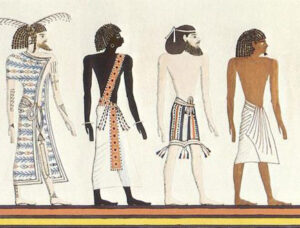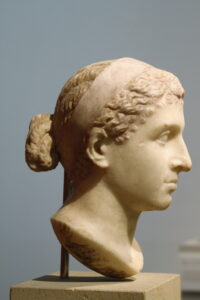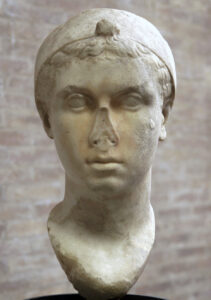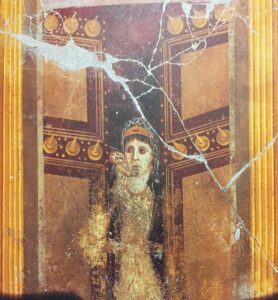by Emanuele Mastrangelo and Daniele Scalea
Here we go again. Netflix is proposing yet another woke retelling of history, this time with a docudrama in which Cleopatra is impersonated by a black actress. This is not a mere "artistic license," about which there would already be controversy. As a documentary, Queen Cleopatra has pretensions to proper historical popularization, and right from the trailer it weighs the skin color it assigns to the Egyptian queen: one of the interviewees states that "it's possible she was an Egyptian" (in the ethnic sense), while another goes even further with a memorable example of historiographical accuracy: "I remember my grandmother telling me, 'I don't care what they tell you at school, Cleopatra was black.'"
Referring to the case, a "La Stampa" (Italian liberal newspapers) article affirms that "Cleopatra's ethnicity has long been the focus of academic discussion.": a phrase that aims to make it seem that, after all, yet another case of blackwashing is nothing more than a legitimate position with historiographical basis, perhaps controversial but solid.
The reality, however, is that there is no doubt about the belonging of Cleopatra VII Tea Philopator (69-30 B.C.), queen of Egypt, to the human group that in the age of political correctness we cannot call "white race" without being accused of "supremacism." And this is in spite of some possible (but highly improbable) quarter of Egyptian blood to which the proponent of blackwashing sticks, for the ancient Egyptians themselves were a Mediterranean people, certainly not one with sub-Saharan features.
Blackwashing: what and why
The blackwashing is that wokist practice that for several years now has been forcibly inserting "multiracial society" into anachronistic contexts, even to the point of ethnic falsification of major characters in history, in cinema, opera and theater. It starts with an unlikely African character placed in a European storyline (typically Morgan Freeman in Robin Hood, 1991) and goes on to black noblewomen during Bridgerton's English Regency (1811-1820). In between we have Achilles, Zeus, St. Peter, Joan of Arc, Julius Caesar, and Margaret of Anjou (just to name a few) played by actors of African descent. As well as anonymous Roman legionaries, Celtic warriors, Cistercian monks, and 17th-century French librarians in films, TV series, and documentaries.
Every such release - modestly disguised behind the locution "color-blind casting" - punctually elicits waves of indignation among white audiences and counter-waves of scandalized articles blaming the "racism" and "supremacism" of those who are not exactly happy to see a character from their own history played by an actor from an ethnic background that does not conform to historical reality (what would one say about a Nelson Mandela played by a white actor?).
What color were the Egyptians?
Before we focus on Cleopatra, let us immediately clear the air of a misunderstanding. "North Africa" is not "Africa" in the sense of "dark continent." North Africa is in the Euro-Mediterranean subregion (part of the Palearctic ecozone) in terms of fauna, flora and human population, separated from the rest of the African continental mass (Ethiopian ecozone) by that Sahara Desert which is a semi-impenetrable barrier, as opposed to the Mediterranean Sea which (as the news of these days show) is instead an open highway with no tolls.

Reproduction of an Egyptian mural in the tomb of Seti I, depicting (from left to right): a Libyan, a Nubian, an Asian, and an Egyptian.
The Egyptians very much marked their racial difference with the Nubians, representing themselves as white (the women) or tan (the men) and stricto sensu "Africans" (from south of the Second Cataract) as black, very black . Greeks and Romans represented with perfect realism the inhabitants of Carthage, Cyrene, Alexandria, Meroe, and in no case do we find a Hannibal or a St. Augustine with sub-Saharan somatic features (also depicted with ethnographic rigor when necessary). After all, ancient geography distinguished between "North Africa" and "Ethiopia" understood as "Black Africa," although the continental mass was later roughly named after a region between Carthage and Numidia.
The Greek Cleopatra
Cleopatra, however, ethnically was not even Egyptian. She was the last descendant of the Ptolemaic dynasty, which had been imposed two centuries earlier on the Egyptian throne when the satrap Ptolemy proclaimed himself pharaoh. This Ptolemy came from Macedonia, that is, from a Greek kingdom. There he had been one of Alexander the Great's somatophylakes (bodyguards), accompanying him in the conquest of his empire and, upon the latter's unraveling following the Macedonian ruler's premature death, received dominion over Egypt.
The Ptolemaic dynasty was one of foreign conquerors. No matter that they claimed the title "pharaohs," the names they gave themselves, still 250 years later (when the dynasty ended), were only Greek: Ptolemy, Cleopatra, Arsinoe, Berenice. Their appellations were in Greek: Soter, Philadelphus, Euergetes and so on, up to Philopator, that of "our" Cleopatra (VII), meaning "who loves her father." By the way, the name Cleopatra means, in Greek, "glory of her father."
The Ptolemaic rulers resided not in Memphis but in Alexandria, the Greek colony founded by Alexander the Great: a metropolis in which Greeks coexisted with Egyptians and Jews, but in which the three ethnic groups remained rather separate. The well-known Library of Alexandria was created as a center of Hellenic culture: it was part of a larger cultural institution, the "Museum," dedicated to the Muses (Greek deities), and collected texts written in Greek; works written in other languages were systematically translated to enter the library's "catalog."
Members of the Ptolemaic dynasty spoke Greek, refusing to learn the Egyptian language. Cleopatra VII is remembered precisely as the first Ptolemaic pharaoh to learn Egyptian, but as part of a broader talent for languages that led her to learn many others. To better preserve the blood lineage intact, Ptolemy's descendants intermarried; often even between siblings. Cleopatra VII was most likely the product of such a union (although some uncertainty remains about the identity of her mother) and, before marrying Mark Antony, had two of her brothers for husbands. When not marrying a sister or cousin, Ptolemaic pharaohs chose Hellenic wives (not necessarily from Greece, but always from ruling dynasties of Greek blood). The only verified non-Greek blood graft in the dynasty was Cleopatra I Sira, wife of the fifth Pharaoh Ptolemy V Epiphanes: her mother was a Pontic princess of Persian blood, while her father had a Sogdian ancestor. Still, we are talking about Indo-European ethnic groups, and we are a long way from Black Africa.
Apart from family origins, we also have some available iconography on Cleopatra. In addition to coins bearing her effigy, at least two coeval busts of her have been preserved (one is in the Altes Museum in Berlin, the other in the Vatican Museums). The busts and coins have no color, but they allow us to know the other somatic features - and there is no hint of sub-Saharan origin in them.
The ultimate proof may lie in a fresco in Pompeii: comparing it with the above-mentioned busts and coins, it has been determined to be very likely to depict Cleopatra VII, to whom it is coeval. And this fresco leaves no doubt, for the skin of the alleged pharaoh is very white.
Conclusions
Yes: because, with all due respect to the authors of the TV series on Cleopatra, there is not the slightest possibility that the last Queen of Egypt was even tanned (women after all until a few decades ago avoided the sun, as the biblical verses of the Song of Songs remind us). This "Overton window" must therefore be immediately closed without appeal by rejecting for what they are, politically interested baloney, attempts to sow doubts around Cleopatra's origin. What is at stake here is not only philological correctness: ethnic substitution is by no means a hoax, as say the detractors of Minister Lollobrigida who dared to evoke it in public; and ethnic substitution begins first and foremost by inserting misunderstandings and hoaxes into the heads of the less savvy, accomplices a large legion of willing slaughterers of our identity.
Redattore del blog del Centro Studi Machiavelli "Belfablog", Emanuele Mastrangelo è stato redattore capo di "Storia in Rete" dal 2006. Cartografo storico-militare, è autore di vari libri (con Enrico Petrucci, Iconoclastia. La pazzia contagiosa dellacancel cultureche sta distruggendo la nostra storia and Wikipedia. L'enciclopedia libera e l'egemonia dell'informazione).
Founder and President of Centro Studi Machiavelli. A graduate in History (University of Milan) and Ph.D. in Political Studies (Sapienza University), he teaches “History and Doctrine of Jihadism” at Marconi University and “Geopolitics of the Middle East” at Cusano University, where he has also taught on Islamic extremism in the past.
From 2018 to 2019, he served as Special Advisor on Immigration and Terrorism to Undersecretary for Foreign Affairs Guglielmo Picchi; he later served as head of the technical secretariat of the President of the Parliamentary Delegation to the Central European Initiative (CEI).
Author of several books, including Immigration: the reasons of populists, which has also been translated into Hungarian.

















👍
Una tendenza culturale imposta, satura di idiosincrasia, e più distruttiva di una contaminazione nucleare. Forse l’unico mezzo possibile per disinnescarla.
Nel tempio che a Mantova (sulle colline sovrastanti la città) il poeta Virgilio dedicò al divino Cesare Augusto ci sono due ritratti in pietra scolpita della regina Cleopatra. In uno il colore della pietra in corrispondenza del viso é grigio scuro. Nel secondo in porfido é sappresentata accanto a
Marco Antonio. Presenta il naso schiacciato e una marcata piega sulla palpebra superiore. Queste sono caratteristiche somatiche dei popoli Nilotici. L’autore delle sculture dovrebbe essere Aulanio Evandro che ben conosceva Cleopatra essendo stato portato da Atene a Alessandria d’Egitto da Marco Antonio e da qui a Roma come schiavo da Ottaviano.
Nel tempio che a Mantova (sulle colline sovrastanti la città) il poeta Virgilio dedicò al divino Cesare Augusto ci sono due ritratti in pietra scolpita della regina Cleopatra. In uno il colore della pietra in corrispondenza del viso é grigio scuro. Nel secondo in porfido é sappresentata accanto a
Marco Antonio. Presenta il naso schiacciato e una marcata piega sulla palpebra superiore. Queste sono caratteristiche somatiche dei popoli Nilotici.
Forse ti riferisci alle colline del Garda, perché Mantova non ha colline nel raggio di 20 km.
In realtà Virgilio non dedicò alcun tempio a Cesare Augusto, ma lo immaginò poeticamente. In ogni caso saremmo curiosi di vedere la foto di questi ritratti d’epoca augustea, che sono anche ben conservati, perché su internet cercando “cleopatra + mantova” (anche in inglese) non esce altro che un busto rinascimentale. Peraltro, che il colore della pietra fosse scuro non rileva, visto che le sculture erano spesso colorate.
Comunque, che Cleopatra potesse avere anche solo una goccia di sangue nilotico nelle vene è completamente da escludersi a meno che qualche sua antenata non abbia avuto avventure extraconiugali con qualche schiavo proveniente dalla Nubia.
Mantova é pianura e collina e la Pieve di Cavriana é posta di fronte alla Basilica di Sant’Andrea di Mantova. La Pieve fu costruita col materiale ricavato dalla demolizione del tempio romano etrusco adiacente. Il tempio fu dedicato dal poeta Virgilio immortale al Divino figlio di Dio Tribuno della Plebe Dio Salvatore. Se mi mettete in condizione vi invio le fotografie.
Si tratta del tempio di cui parla Virgilio nel libro terzo delle Georgiche. È posto a 30 km di distanza dalla città esattamente dirimpetto alla fine delle colline moreniche del lago di Garda. È un territorio patrimonio dell’UNESCO per gli insediamenti dell’età del bronzo ma importante anche in epoca etrusca e romana. Di questi ultimi insediamenti si parla ancora molto poco.
Se Cleopatra era una figlia illegittima del Faraone e di una concubina nilotica queste caratteristiche somatiche sono compatibili. La scultura (Aulanio Evandro?) ha caratteristiche pittoriche e prospettiche che sono quelle che verranno riprese nello stiacciato del Rinascimento.
Antonio e Cleopatra sono rappresentati accostati. Antonio più in alto e con caratteristiche somatiche caucasiche porta sopra la testa un’aquila. Cleopatra un gradino in basso ha caratteristiche somatiche nilotiche. Questo in una più grande scultura che rappresenta il Dio Ammone e Ottaviano Cesare Augusto Faraone d’Egitto.
Nel tempio di Mantova, che era dedicato a Agdos la madre degli Dei, Cleopatra è divinizzata e rappresentata come Iside. Questo corrisponde alle tradizioni romane che assumevano nel proprio pantheon le divinità straniere. Non era sicuramente nella volontà di Augusto uccidere Cleopatra che voleva solo portare con sé nel trionfo a Roma,diversamente da Cesarione che sicuramente fece uccidere. Col suicidio la Regina fu divinizzata e questo Ottaviano lo riconobbe. Sicuramente non ebbe alcuno scrupolo nel fare uccidere Cesarione.
Why do you call Adele James black? She is the actress who portrays Cleopatra VII in the docudrama. However, she does not look black, but is a sort of light brown. She is mixed race but far from looking black.
There is not only uncertainty about Cleopatra’s mother but also about her grandmother. Her father was called a bastard. So it is likely she had some recent Egyptian ancestry. So we really don’t know what Cleopatra’s skin tone was. It may be not that far off from that of Adele James. Start with Episode 1 at about 17 minutes, and you can see Adele in the sunlight.
And what difference does it make to the story told in the docudrama?
It makes a huge difference because portraying an historical figure that clearly belonged to a certain race as another race is falsifying history! Although we don’t know exactly who Cleopatra’s mother was we can confidently affirm she was caucasian because of her European ancestry and the strict practices of intermarrying which maintained her ethnic lineage, not to mention the obvious evidence of her appearance left to us by the many statues and coins depicting her. Because of these two facts we know beyond the shadow of the doubt that Cleopatra was caucasian and had caucasian traits.
But, aside from the Cleopatra controversy, this “blackwashing” goes way beyond the individual instances, it’s a tool of the extreme left to conquer the world.
As an Italian-American living in the thick of it, I am getting totally fed up by this “woke” movement bent on the systematic defaming, diminishing, detracting and appropriation of European and American history which is, in plain terms, nothing less than an assault on the “white man” himself, his culture and his heritage!
Why is this done, you may ask? Officially, to wrestle away the unfair hegemony of power from the “evil, white man.” In reality; to conquer and subjugate the only race that has being capable of creating free, advanced and enlightened societies and still stands as the last bastion of freedom in the world. Many European countries, Canada and Australia, however, have already being subdued, but America still hangs on, though if things don’t change soon, will be conquered as well.
The conspirators’ plan (a.k.a politicians and their financial sponsors, the rich world’s elite) is to take complete control of the world by first destroying “white people” and taking over their countries by various means, including but not limited to:
Destroying public schools mission and effectiveness of educating our children in secular subjects.
Indoctrination children in schools and colleges against own country, capitalism, patriarchy, heterosexuality, Christian religion, the family, morality and anything that has to do with national identity and pride;
Promoting savage immigration to replace white people with populations and races that have extremely different cultures and values, that have no common history, nor language nor religion with Europeans and who, in many cases, flat out hate them. Because of those facts, new “immigrants” often do not feel any particular affection or allegiance to their hosting countries, they do not understand their values and democratic principles and fail to integrate;
Demonizing and removing law and order, thus creating chaos. Chaos creates malcontent, malcontent demands actions by politicians, politicians blame each other for the situation while hiding their own responsibilities, they then implement draconian and oppressive measures to “resolve” the problems they created in the first place thus gaining more power over the people;
Manufacturing economic hardship through inflation, closing of factories and mines, social unrest and health crises;
Through environmental nazism, which promotes extreme regulations and demands absurd actions such as: destroying all cows, stop cultivating crops, closing coal mines and stop drilling for oil, which in turn causes more economic hardship. (Let me open a parenthesis and share with you a little secret as to why this is also done: the politicians who push for these actions, aside from ideological reasons, have invested heavily in emerging technologies such as solar and wind, or have received bribes from other countries that want to export their products, and that is why they promote policies they know are detrimental to their countries. In their minds those politicians and rich corporate people who control their counties and the world, believe they have the right to control them and get rich in the process.);
Either hiding, changing, or denigrating white people’s history, which will result in self doubt, self shame and self hate;
Promoting intermarriages, which will “dilute” and eventually eliminate “white blood” and thus create an homogenous, barely educated, brown race that will be easily controlled.
That is the world’s elite final goal; to destroy white societies and replaced them with a more complacent and controllable, generic, brown race, thus allowing them to install a universal dictatorship that oppresses billions.
And this is why white people get really ticked off by backwashing; because it is a mean to an end, namely the end of the white race.
Condivido in pieno tutto quello che avete detto. “Blackwashing” e’ un metodo per cancellare la cultura Europea sia in Europa che in ogni altro paese del mondo fondato dagli Europei per motivi politici e dunque di potere. Ed e’ assolutamente vero che la sostituzione etnica comincia prima inserendo interpretazioni sbagliate o interamente false nei cervelli di gente meno colta, creano cosi’ legioni di imbecilli ben disposti a distrugge la nostra identità. Io vivo negli Stati Uniti da moltissimi anni ed ho visto questo processo prendere sempre più piede nelle nostre scuole e università, culminando poi in violenza sfrenata in opposizione a Trump. I nostri giovani sono stati indottrinati nel credere di essere cattivi e di non aver mai fatto nulla di buono, mentre le altre razze di essere sempre vittime dei bianchi e di non far mai niente di male. Entrambi teorie sono completamente false! Continuate a contrastare la menzogna, a difendere la cultura Europea ed a dire sempre la verità.